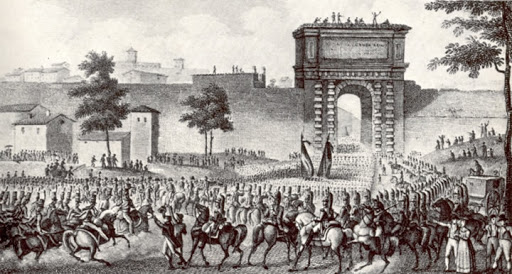Our story begins when, in the spring of 1796, the revolutionary troops commanded by General Napoleon Bonaparte entered Milan (he had changed the surname of Tuscan origin Buonaparte shortly before the campaign of Italy to adapt it to the French language).
After the victories against the Austro-Piedmontese, first, and papal troops, then, the general insituted in the conquered territories of temporary governments, which formally were to replace the French military administration: thus the first sister republics were born. In the territories belonging to the Papal States the Cispadana Republic was established; while in Lombardy and in the territories on the left of the Po the Transpadana Republic was created.
In Milan was installed a military committee composed of Caccianino Antonio, Tordorò Giovanni, Beccaria Annibale, Visconti Aimi Francesco, Lahoz Giuseppe, Trivulzio Alessandro, to which were added the heads of the city guards Duke Galeazzo Serbelloni and Lawyer Pietro Teulié, who along with other fervent Lombards, had adhered to the proclamation of Bonaparte. These characters were important personalities of the ancien régime and Jacobins of the first hour, which we will know better later.
The decree of 19 August 1796 established the Milanese National Guard, whose uniform, unlike the French blue, was green with collar and sleeves edged with red. The existence of the Cispadana Republic also allowed the creation of a military corps, the Lombard Legion.
Thus, with the decree of 15 October 1796, the first Italian military unit was created under the command of the Mantuan general Giuseppe Lahoz to whom Teulié was assigned as adjutant general and at the same time head battalion.
This first unit, consisting of “spontaneous inscriptions” included 3741 legionaries, divided into 7 cohorts, five centuries, as well as one of grenadiers and one of hunters, which was assigned an artillery division of 4 guns.
